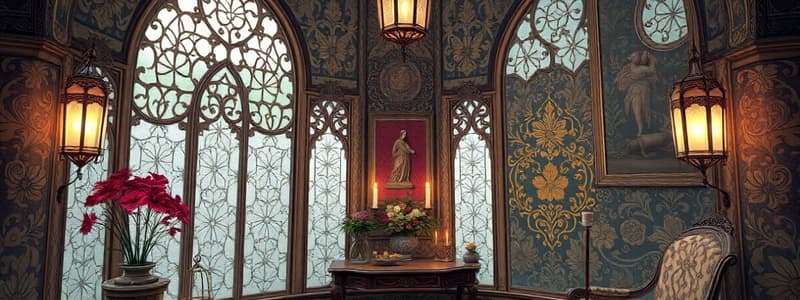Podcast
Questions and Answers
What is a primary characteristic of Surrealism in art?
What is a primary characteristic of Surrealism in art?
- Explores the unconscious mind through dream-like imagery (correct)
- Utilizes geometric shapes exclusively
- Combines abstract forms with realistic features
- Focused on realistic representation of objects
Which technique involves creating an arrangement of disconnected images and forms to produce a sense of dream-like dislocation?
Which technique involves creating an arrangement of disconnected images and forms to produce a sense of dream-like dislocation?
- Stacked Vessels
- Distorted Grid Drawing
- Cubism
- Exquisite Corpse (correct)
In Cubism, how are objects typically represented?
In Cubism, how are objects typically represented?
- In a fragmented form to convey multiple perspectives (correct)
- In their natural colors without distortion
- Only in black and white tones
- As realistic sculptures
What is the purpose of using analogous colors in a digital portfolio?
What is the purpose of using analogous colors in a digital portfolio?
What aspect does a distorted grid drawing primarily focus on?
What aspect does a distorted grid drawing primarily focus on?
Flashcards
Digital Portfolio
Digital Portfolio
A digital portfolio is a collection of online work showcasing skills and experience.
Exquisite Corpse
Exquisite Corpse
Exquisite Corpse is a collaborative drawing game where each participant contributes to a drawing without seeing the previous additions, resulting in unexpected and surreal outcomes.
Surrealist Landscape
Surrealist Landscape
Surrealist Landscape refers to landscapes that defy logic and perspective, often featuring dreamlike elements and juxtapositions.
Surrealist Eye
Surrealist Eye
Signup and view all the flashcards
Cubism Shattered Values
Cubism Shattered Values
Signup and view all the flashcards
Study Notes
Digital Portfolio
- A digital portfolio is a collection of digital assets showcasing skills and work, often used for career advancement or showcasing creativity.
- It can include but is not limited to: design projects, coding examples, writing samples, or pieces of art
- Platforms like Behance, Dribbble, or personal websites are commonly used to establish and manage a digital portfolio.
- The portfolio demonstrates skill development and project progression for evaluation.
Exquisite Corpse
- A collaborative Surrealist artwork technique where each contributor adds a section to a pre-existing work, creating a unique, unexpected composition.
- The unpredictable nature of the final piece embodies the desired sense of spontaneity and mystery.
Surrealism Landscape
- Surrealist landscapes often portray dreamlike, illogical settings that represent subconscious imagery.
- The landscapes can incorporate absurd juxtapositions of objects and elements that defy common logic or reality.
Surrealist Eye
- The Surrealist understanding of the human eye is one of detached observation, emphasizing the subconscious and irrational over logic.
Cubism Shattered Values
- Cubism represented a departure from traditional artistic norms, shattering perspective and creating multiple viewpoints simultaneously.
- This technique challenged traditional realistic representation by showing fragmented aspects.
Distorted Grid Drawing
- A technique where a grid is drawn on the subject and copied with distortion, often used in Cubist or abstract art to create unusual perspectives.
- It aims at presenting multiple viewpoints simultaneously.
Stacked Vessels
- A compositional arrangement of several overlapping or stacked vessels in an artwork.
- It offers a sense of depth or layering, creating both balance and visual intrigue.
Parabolic Curves
- Parabolic curves are smooth, open curves often incorporated in surrealist or abstract art.
- They have applications in creating visual interest.
Analogous Colors
- Analogous colors are colors that are adjacent on the color wheel, generally creating a harmonious and cohesive aesthetic.
- Their use often creates a sense of unity and visual balance within compositions.
Value
- Value refers to the relative lightness or darkness of a color or form.
- Understanding and manipulating value is fundamental in creating dimension, depth, and mood in art.
- It is an important concept in portraying reality and creating illusions or effects in artwork.
Studying That Suits You
Use AI to generate personalized quizzes and flashcards to suit your learning preferences.




